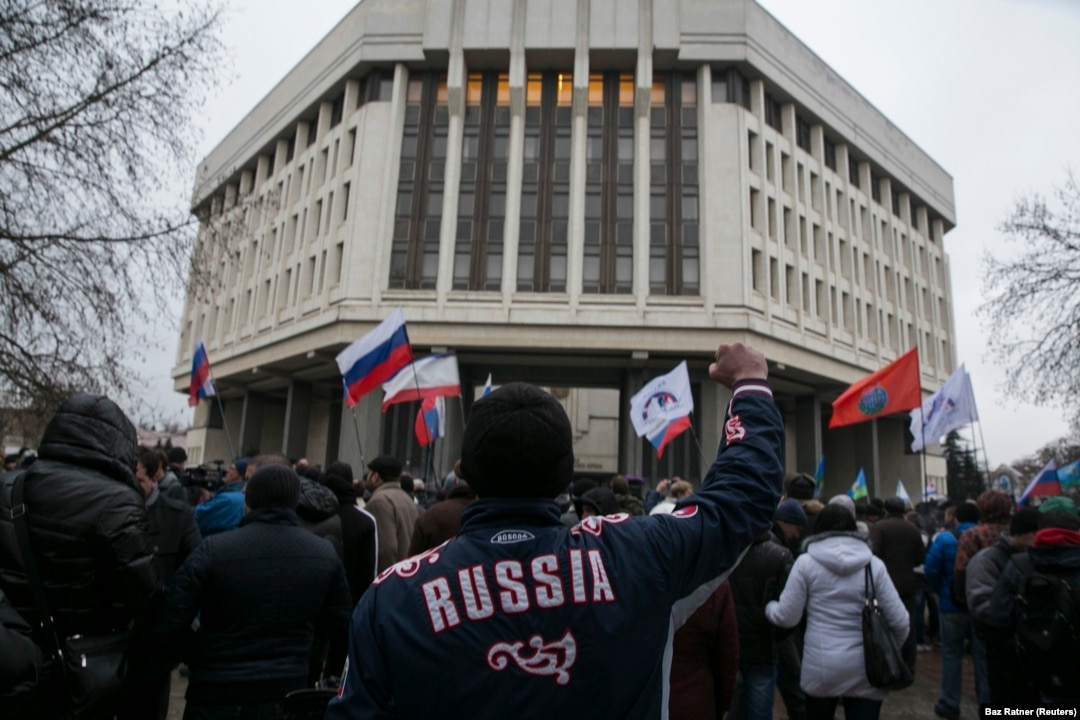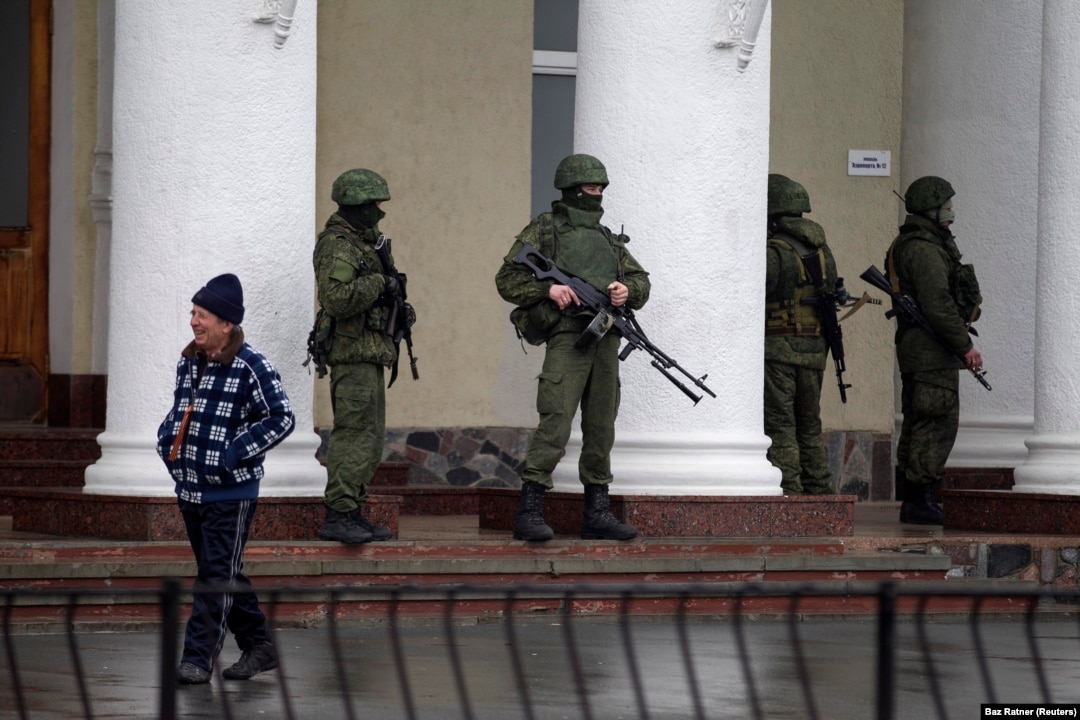Takeover: The Russian Occupation Of Crimea, 10 Years Ago

Crimean Tatars hold the flag of their people during a rally at the Crimean parliament in Simferopol on February 26, 2014.
One week earlier, a Crimean politician raised the possibility of the peninsula’s “secession” from Ukraine. Kyiv street protesters at the time were in the process of ousting pro-Russian President Victor Yanukovych from power in what Ukrainians came to call the “revolution of dignity.”

A pro-Russian crowd outside the Crimean parliament on February 27.
Earlier that day, around 60 pro-Russian gunmen had seized the building, as well as several checkpoints on the Crimean Peninsula.

Russian soldiers operating without insignia stand outside the Simferopol airport on February 28.
Incognito Russian soldiers appeared throughout Crimea and became known as “little green men.” The Kremlin initially claimed the soldiers were local “self-defense” groups but later admitted they were professional Russian soldiers.
Unmarked Russian soldiers and vehicles surround a Crimean border-guard base in Balaclava on March 1.
The same day, Crimea’s pro-Russian prime minister appealed to the Kremlin to "provide assistance in ensuring peace and tranquility" in Crimea.
Local residents surround a truck driven by Ukrainian soldiers on March 3.
Large numbers of pro-Russian locals in Crimea began turning out on the streets alongside unmarked Russian soldiers, adding pressure on Ukrainian troops who were increasingly isolated within their military bases. Crimea at the time was populated by around 60 percent ethnic Russians.
A Russian soldier watching Ukrainian military personnel at the Belbek airport, near Sevastopol.
The Ukrainian Air Force base became one of the last Ukrainian holdouts in Crimea as its commander refused to hand over the site to Russian troops. He was eventually detained by Russian forces and Ukrainian personnel were forced out.
Pro-Ukrainian protesters in front of the Crimean parliament building in Simferopol on March 8
As pro-Russian forces cut Ukrainian news broadcasts and began transmitting Russian state television channels, several teams of foreign journalists working in Crimea were physically attacked, and two Ukrainian journalists were kidnapped.
Crimean Tatars warm themselves around a fire while guarding their neighborhood on March 9.
Ukraine’s interim Prime Minister Arseniy Yatsenyuk vowed Ukraine would not relinquish "an inch" of its territory as Russia’s takeover of Crimea solidified and life became increasingly dangerous for locals opposed to the illegal annexation.
Russian separatists beat a pro-Ukrainian man with a bat and whip in Sevastopol on March 9, as a rally in support of Kyiv was attacked by pro-Russian activists.
A man walks past a poster in Sevastopol on March 10 depicting a referendum called by Crimea’s pro-Russian authorities as a choice between Nazism and Russia.
The March 16 referendum, which did not offer the option of Crimea retaining its status quo, was declared illegal by Kyiv and not recognized by most countries. Voters overwhelmingly opted to rejoin with Russia in a vote that was widely dismissed as falsified.
A massive rally in Moscow on March 15 opposing the military takeover of Crimea
Putin later revealed he had voiced his intention to "start working on returning Crimea to Russia" in February 2014 at the end of an all-night meeting with his security services.
Election officials of the Russian-installed Crimean authorities arrive at a house in Simferopol with a mobile ballot box during voting in the referendum on March 16.
Crimea was "gifted" to the Ukrainian S.S.R. in 1954 by Soviet leader Nikita Khrushchev in a move that was mostly symbolic at the time but had profound consequences after the breakup of the Soviet Union.
A woman celebrates in Sevastopol on March 18 as a crowd watches a live broadcast of Putin following the results of the disputed referendum.
The Russian president addressed Crimeans as “citizens of Russia” during the address.
Two women believed to be from the Ukrainian military carry uniforms as they leave a military base and walk past a Russian soldier on March 19.
Crew members of the Ukrainian naval warship Konstantin Olshansky, which was blockaded by Russian warships, arrive on shore after leaving their ship on March 23.
The ship was later seized and incorporated into the Russian Navy.
A man draped in the Russian flag stands on the coast of Sevastopol on a stormy day in March.
With the Crimean Peninsula firmly under Russian control, on April 7 the stage was set for war when pro-Russian groups in Donetsk and Luhansk burst into government offices and helped themselves to weaponry. Kyiv responded by announcing the start of a "counterterrorism" operation.

